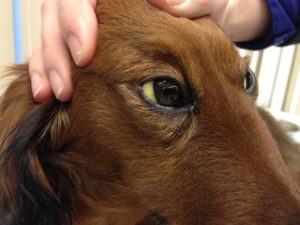Case 3: Coco
Case 3: Coco (Client Information)
General History:
Coco is a 10-year-old spayed female Siamese cat (chocolate point). You have owned her since she was a kitten, and obtained her from a breeder recommended by your veterinarian. You moved from Ottawa to Guelph a few weeks ago. Coco was very stressed during and after the move. She is hiding under your bed since the move. You put her water, food, and litterbox in that bedroom. Some days it looks like a bit of the kibble has been eaten, but you are not sure how much she is eating. Today you have noticed that the whites of her eyes now look yellow, and she is very lethargic.
Systems Review:
If specifically asked by the veterinarian, you can give the following information:
- Attitude: Usually a very active cat (if probed, describe cat running, jumping, playing). Seems more “depressed” now (if probed, describe cat less active, weaker than usual).
- Appetite/weight change: Decreased appetite in the last 3 weeks, hardly eating anything over past week. Coco will occasionally eat a little from your hand. When petting her, Coco’s owner thinks she feels more “bony” over her back and ribs.
- Water consumption/urination: Seems to be drinking less. You cannot comment on urination because you have not checked the litter box.
- Vomiting/diarrhea: No vomiting noted. You are not having to clean the letterbox as often as usual, but urine & feces seems normal when you do clean it.
- Other signs of disease (e.g., coughing, sneezing, etc): No.
Previous medical history:
If specifically asked by the veterinarian, you can give the following information:
- In Ottawa, Coco’s veterinarian was your close family friend. You followed all recommendations for routine wellness care each year. Last year, Coco had a dental cleaning at that clinic due to tartar buildup and gingivitis, and you think she recovered very quickly from this with no concerns. No teeth were taken out during the dental cleaning.
- Coco’s health has been excellent up until this concern.
Current Health Status:
If specifically asked by the veterinarian, you can give the following information:
- Environment: Exclusively indoor cat. There is another animal in the house, a 5-year-old Shetland sheepdog who gets along well with Coco. About 3 weeks ago you moved from London to a new home in Guelph.
- Diet: Normally fed Royal Canin Adult kibble (half of a cup twice daily, and you use a measuring cup to ensure it is the proper amount). You give Coco a spoonful of tuna as a treat once a week.
- Vaccination: Last vaccinated 8 months ago. Unsure the actual vaccines, but it was what the veterinarian recommended.
- Parasite control: You don’t recall giving anything for flea/parasite control, and you don’t think this is needed due to her indoor lifestyle.
Case 3: Coco (Veterinarian Information)
This is Coco’s first visit to your clinic. She is is a 10-year-old spayed female Siamese cat (chocolate point). Your appointment list notes that she is not eating in the past 3 weeks, and she has yellow eyes.
After the client called to book the emergency consultation this morning, your receptionist was able to contact the vet in Ottawa and obtain the previous medical history. Coco was last vaccinated 8 months ago with Rabies, and the combination vaccine for feline herpesvirus, calicivirus, and panleukopenia (routinely recommended “core” vaccines in cats). Bloodwork (complete blood count and serum biochemical profile) prior to the dental cleaning last year was normal, and the cleaning was performed routinely under anaesthesia with no problems on recovery. The record details routine wellness visits each year, and each notes Coco to be in excellent health with normal physical examinations each time.
When you greet the client you note that the cat appears very dull in attitude, and you can appreciate a yellow colour to the inside of the ear pinnae as well as on the sclera of the eyes (an aside: this is sometimes referred to as “jaundice” but that term is a bit specific in people and we will call this “icterus” in our patients. Here is an example of icterus in a dog:)

Body weight at the previous clinic was 4.8 kg, and today upon check-in the cat weighs 3.6 kg.

